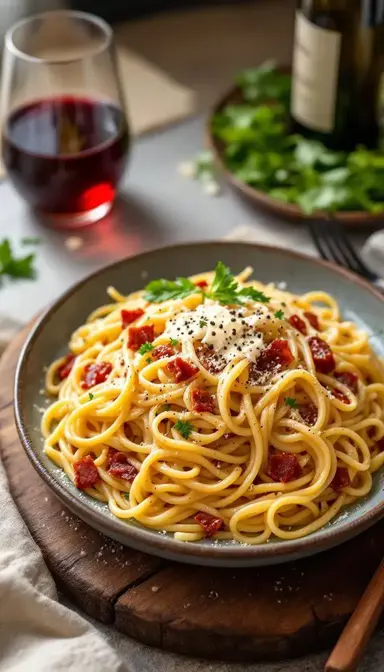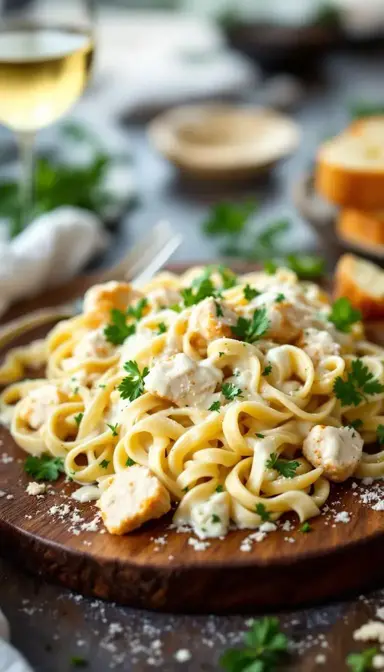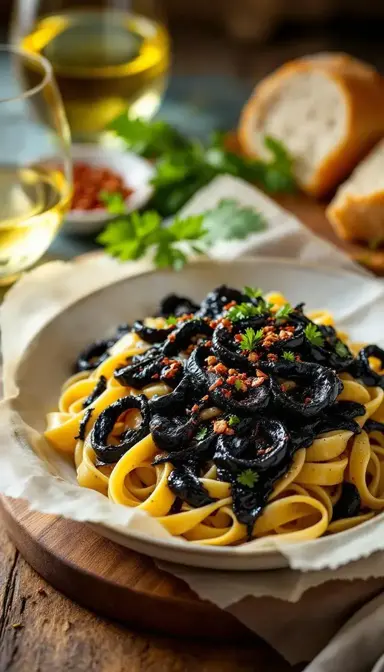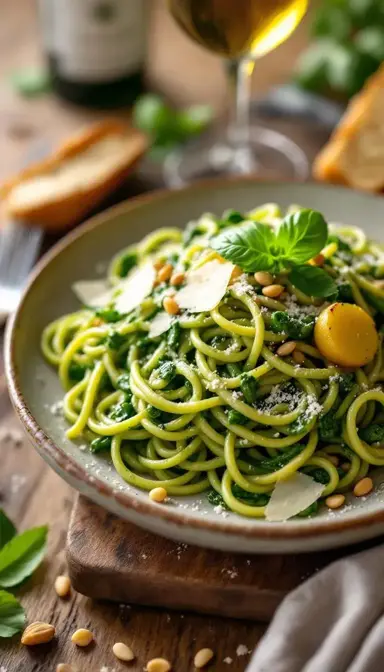Let me tell you about the first time I truly understood carbonara. It wasn’t in some candlelit Roman trattoria, but in my tiny Brooklyn kitchen at 11 PM, standing barefoot on cold linoleum with a fork in one hand and a well-worn copy of Marcella Hazan’s cookbook in the other. That moment—when the eggs transformed into golden silk around the pasta—changed how I saw simplicity forever.
This is why Pasta Carbonara with Pancetta isn’t just a recipe; it’s a culinary tightrope walk between restraint and indulgence. Five ingredients. One skillet. A dance of heat and timing that turns pantry staples into something transcendent. No cream, no fancy techniques—just the alchemy of good eggs, salty pancetta, and cheese that whispers of grassy Italian hillsides.
Why This Recipe Works
- Less is more: Like a perfectly tailored suit, carbonara’s power lies in what’s left out.
- 30 minutes to glory: Faster than delivery, more satisfying than takeout.
- Pancetta over bacon: Think of it as bacon’s more sophisticated cousin—cleaner, meatier, without the smoke.
- Eggs at room temp: Cold eggs are the enemy of silk. Leave them out like you would for baking.
The Story Behind the Sauce
The origins of carbonara are murkier than a bowl of just-tossed spaghetti. Some say it was born in the Apennine mountains, fuel for coal miners (*carbonai*). Others swear American GIs introduced eggs and bacon to pasta-starved Rome after WWII. The truth? It doesn’t matter. What does is how this dish captures the Italian genius for turning poverty into poetry—a handful of humble ingredients transformed through technique into something worthy of a silver fork.
Essential Ingredients & Tools
Ingredients
- For the Sauce (The Backstage Crew)
- 3 whole eggs + 2 yolks: Like a velvet rope at a club, the yolks are where the magic happens.
- 1½ oz (45g) Pecorino Romano: Salty, funky, unapologetic—the punk rocker of cheeses.
- 1½ oz (45g) Parmigiano-Reggiano: The smooth-talking diplomat balancing Pecorino’s edge.
- 1½ tsp black pepper: Not the pre-ground dust—grind it like you mean it.
- For the Main Dish
- 6 oz (170g) pancetta, diced: About 6 oz—enough to make every forkful a treasure hunt.
- 12 oz (340g) spaghetti: The classic, though I’ll tell you about bucatini later if you’re feeling adventurous.
- 1 cup pasta water: Liquid gold. Save a cup or regret it by dessert.
- 2 tbsp kosher salt: For boiling the pasta—about 2 tbsp per gallon of water.
Tools You’ll Need
- Large pot: Pasta needs room to swim.
- Heavy skillet (10–12 inches): Cast iron or stainless steel—holds heat like a Roman summer.
- Mixing bowl: For the egg and cheese mixture.
- Tongs: The best tool for tossing pasta.
- Microplane grater: The difference between snowy cheese dust and sad shreds.
Serves 4 | Prep Time: 10 mins | Cook Time: 15 mins | Total Time: 25 mins
How to Make Pasta Carbonara with Pancetta
- Prep the Egg Mixture (The Trust Fall)
In a large mixing bowl, whisk together the 3 whole eggs, 2 yolks, 1½ oz (45g) Pecorino Romano, 1½ oz (45g) Parmigiano-Reggiano, and 1½ tsp black pepper until smooth—no streaks of egg white. Room temp eggs blend evenly, reducing the risk of curdling. Set the bowl near the stove. Pro tip: Grate your own cheese. Pre-shredded varieties contain anti-caking agents that make the sauce grainy.
- Render the Pancetta
Place the 6 oz (170g) diced pancetta in a cold skillet, then turn the heat to medium. Starting cold allows the fat to render slowly, ensuring crispy pancetta without burning. Cook for 8–10 minutes, stirring occasionally, until golden. Transfer the pancetta to a paper towel-lined plate, leaving 2 tbsp of fat in the skillet.
- Cook the Pasta
Bring a large pot of water with 2 tbsp kosher salt to a boil. Add the 12 oz (340g) spaghetti and cook until al dente (about 1 minute less than package instructions). Reserve 1 cup of pasta water before draining. Never rinse the pasta—you’ll wash away the starch needed for the sauce to cling.
- Emulsify the Sauce
Remove the skillet from heat to prevent scrambling the eggs. Add the drained pasta to the pancetta fat, tossing to coat. Quickly pour in the egg mixture and ¼ cup of reserved pasta water. Using tongs, lift and toss the pasta vigorously—this motion distributes heat evenly and encourages the sauce to thicken.
- Finish & Serve
Gently fold in the crispy pancetta. If the sauce seems too thick, add more pasta water 1 tbsp at a time. Serve immediately in warmed bowls. Top with extra Pecorino and a crack of black pepper.
Pro Technique
The Cold Pan Trick
Starting pancetta in a cold pan allows the fat to render slowly, preventing burnt edges. Listen for a steady sizzle—it should build gradually, not aggressively.
The Lift-and-Toss
This isn’t stirring—it’s aerating. By lifting the pasta high with tongs, you expose every strand to air, cooling it slightly to avoid curdling the eggs while coating each piece evenly.
Chef’s Wisdom
Room Temp Eggs Aren’t Scary
Cold eggs hitting hot pasta shock and curdle. Room temp eggs blend smoothly, cooking gently from the pasta’s residual heat. Freshness test: Drop an egg in water. If it sinks, it’s fresh.
Salt Like You’re Seasoning the Ocean
Your pasta water should taste like the sea—about 2 tbsp of kosher salt per gallon. This seasons the pasta from within so your sauce doesn’t need extra salt later.
Storage & Freshness Guide
Leftovers Revival
Refrigerate leftovers in an airtight container for up to 24 hours. To reheat, add a splash of water and warm gently in a skillet over low heat, tossing constantly. Microwaving risks rubbery eggs.
Food Safety Note
While residual heat cooks the eggs, those with compromised immunity can use pasteurized eggs. Discard any leftovers left at room temperature for over 2 hours.
Perfect Pairings
Complementary Dishes
- Arugula Salad: The peppery bite of arugula cuts through carbonara’s richness. Toss with lemon vinaigrette and shaved Parmigiano for a bright contrast.
- Roasted Cherry Tomatoes: Their caramelized sweetness balances the saltiness. Roast at 400°F (200°C) until blistered—about 15 minutes.
Drinks
- Chianti Classico: This medium-bodied red’s acidity scrubs the palate clean. Serve slightly chilled (60°F/16°C) to highlight its cherry notes.
- Sparkling Water with Citrus: Effervescence resets the palate between bites. Add a twist of grapefruit for bitterness that mirrors Pecorino.
Something Sweet
- Dark Chocolate Espresso Beans: A post-meal nibble of 70% dark chocolate with espresso-coated beans echoes carbonara’s bitterness and perks up the senses.
- Lemon Sorbet: A scoop of tart sorbet is the ultimate palate cleanser. The citrus sharpness contrasts the dish’s creaminess beautifully.
FAQs
- Can I use bacon?: Yes, but it’s smokier. Reduce added salt to balance the flavor.
- Is it safe to eat raw eggs?: The residual heat cooks them, but use fresh, high-quality eggs for safety.
- Why is my sauce watery?: You added too much pasta water too fast. Add it gradually, 1 tbsp at a time, until the sauce reaches the desired consistency.

Pasta Carbonara with Pancetta: Rome’s Gift to Weeknight Dinners
Master the art of Pasta Carbonara with Pancetta in just 25 minutes! Creamy, salty, and utterly satisfying—this is weeknight magic. Get the recipe now!
Ingredients
For the Sauce
-
3 large eggs
-
2 large egg yolks
-
1½ oz Pecorino Romano (finely grated)
-
1½ oz Parmigiano-Reggiano (finely grated)
-
1½ tsp black pepper (freshly ground)
For the Main Dish
-
6 oz pancetta (diced)
-
12 oz spaghetti
-
1 cup pasta water (reserved)
-
2 tbsp kosher salt (for boiling)
Instructions
-
In a large bowl, whisk together 3 eggs, 2 yolks, 1½ oz (45g) Pecorino Romano, 1½ oz (45g) Parmigiano-Reggiano, and 1½ tsp black pepper until smooth.01
-
Cook 6 oz (170g) pancetta in a cold skillet over medium heat until crispy, 8–10 minutes. Reserve 2 tbsp fat.02
-
Cook 12 oz (340g) spaghetti in 2 tbsp kosher salt boiling water until al dente. Reserve 1 cup pasta water, then drain.03
-
Remove skillet from heat. Toss pasta with pancetta fat, then add egg mixture and ¼ cup pasta water. Toss vigorously.04
-
Fold in pancetta. Adjust consistency with more pasta water if needed. Serve immediately.05



